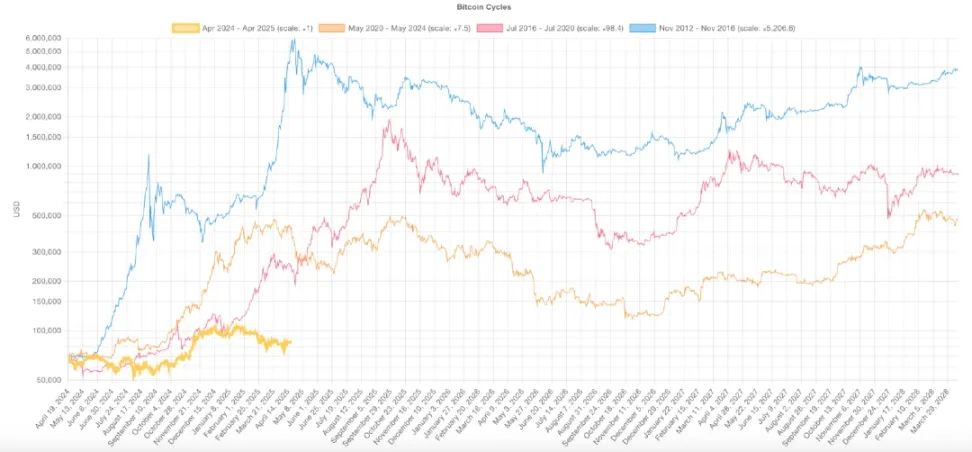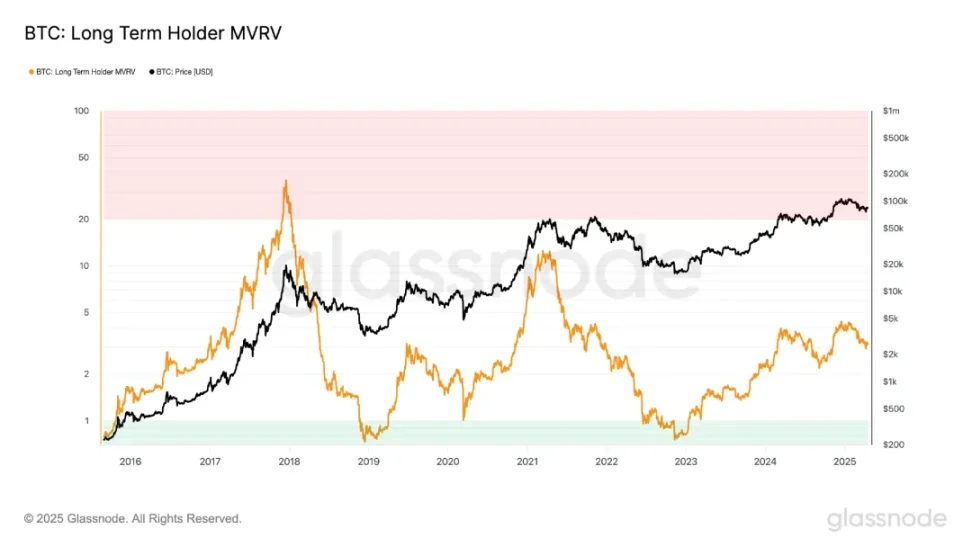Author: beincrypto
Translation: Blockchain Knight
It has been a year since BTC's last halving, and this cycle is showing a distinctly different trend compared to previous ones. Unlike past cycles that experienced explosive increases after halving, BTC's current rise has been relatively moderate, increasing by only 31%, while the previous cycle saw a staggering 436% increase during the same period.
At the same time, indicators for long-term holders (such as the MVRV ratio) show a sharp decline in unrealized profits, indicating that the market is maturing and upward potential is being compressed. Overall, these changes suggest that BTC may be entering a new era characterized not by parabolic peaks, but rather by more gradual growth driven by institutions.
BTC One Year After Halving: A Distinct Cycle
The development of the current BTC cycle is markedly different from previous cycles, which may indicate a shift in how the market reacts to halving events.
In earlier cycles (especially from 2012 to 2016 and from 2016 to 2020), BTC typically experienced strong upward movements during this phase. The period following halving was usually accompanied by intense upward momentum and parabolic price trends, primarily fueled by retail enthusiasm and speculative demand.
However, the current cycle has taken a different path. Prices did not accelerate after halving; instead, they began to surge as early as October and December 2024, followed by a consolidation in January 2025 and a pullback in late February.
This pre-emptive surge is starkly different from historical patterns, where halving typically acted as a catalyst for significant price increases.
Several factors contribute to this shift. BTC is no longer merely a speculative asset driven by retail investors; it is increasingly viewed as a mature financial instrument. The participation of institutional investors is rising, coupled with macroeconomic pressures and changes in market structure, leading to a more cautious and complex market response.

BTC Cycle Comparison. Source: Bitcoin Cycles Comparison
Another clear sign of this evolution is the diminishing intensity of each cycle. As BTC's market capitalization grows, the explosive gains seen in earlier years are becoming increasingly difficult to replicate. For example, in the cycle from 2020 to 2024, BTC rose by 436% one year after halving.
In contrast, the current cycle has seen a much more modest increase of only 31% during the same timeframe.
This shift may indicate that BTC is entering a new chapter characterized by reduced volatility and more stable long-term growth. Halving may no longer be the primary driving force, with other factors such as interest rates, liquidity, and institutional capital playing a larger role.
The rules of the game are changing, and BTC's trajectory is changing as well.
Nevertheless, it is worth noting that previous cycles also experienced phases of consolidation and pullbacks before resuming an upward trend. While this phase may feel slow or lacking in excitement, it could still represent a healthy adjustment before the next rally.
That said, this cycle may continue to deviate from historical patterns. It may not experience a dramatic top bubble burst but instead present a more sustained and structurally sound upward trend, driven more by fundamentals than speculation.
Long-Term Holder MVRV Ratio Reveals BTC's Mature Market
The market value and MVRV ratio of long-term holders (LTH) have been reliable indicators of unrealized profits. It shows the profits that long-term investors have gained before they start to sell. However, over time, this value has been declining.
During the cycle from 2016 to 2020, the LTH MVRV ratio peaked at 35.8, indicating significant paper profits and a clear top forming. By the cycle from 2020 to 2024, this peak sharply dropped to 12.2, even though BTC's price reached an all-time high at that time.
In the current cycle, the highest LTH MVRV ratio so far is only 4.35, a significant decline. This indicates that the profits gained by long-term holders are far lower than in previous cycles, despite the substantial increase in BTC's price. This trend is clear: the profit multiples in each cycle are decreasing.
The explosive upward potential of BTC is being compressed, and the market is maturing.
Currently, in this cycle, the highest reading of the LTH MVRV ratio so far is 4.35. This significant decline indicates that the profit multiples for long-term holders are much lower compared to previous cycles, even with the substantial rise in BTC's price. This pattern points to a conclusion: BTC's upward potential is being compressed.

BTC Long-Term Holder MVRV. Source: Glassnode
This is not a coincidence. As the market matures, explosive returns naturally become harder to achieve. The era of extreme, cycle-driven profit multiples may be fading, replaced by more moderate or stable growth.
The growing market size means that exponentially more capital is needed to significantly drive prices up.
However, this does not confirm that this cycle has peaked. Previous cycles typically included long periods of consolidation or slight pullbacks before reaching new highs.
As institutional investors play an increasingly important role, the accumulation phase may last longer. Therefore, the sell-off of peak profits may not be as sudden as in earlier cycles.
However, if the trend of declining MVRV ratio peaks continues, it may reinforce the view that BTC is transitioning from frenzied, cyclical surges to a more moderate but structured growth pattern.
The most dramatic increases may be behind us, especially for investors entering the market in the later stages of the cycle.
免责声明:本文章仅代表作者个人观点,不代表本平台的立场和观点。本文章仅供信息分享,不构成对任何人的任何投资建议。用户与作者之间的任何争议,与本平台无关。如网页中刊载的文章或图片涉及侵权,请提供相关的权利证明和身份证明发送邮件到support@aicoin.com,本平台相关工作人员将会进行核查。




